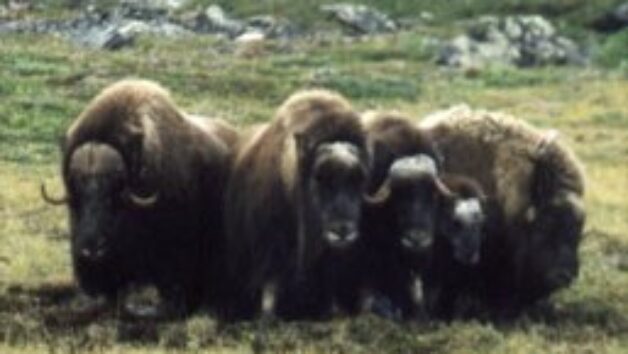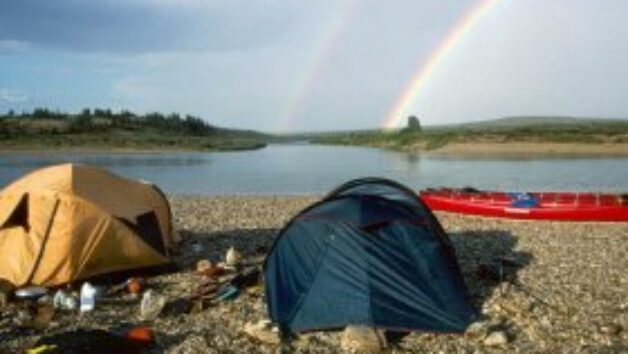Kuujjua River, Victoria Island, NWT Summer 1998
Dear Alv and Linda,
This summer we spent four weeks on the Kuujjua River on Victoria Island in the Northwest Territories. This trip was one of our favorite trips, in fact it is Joel’s favorite tundra river because of all the wildlife (muskox, caribou, hawks, cranes and swans), magnificent scenery (reminiscent of the buttes of south west United States), minimal evidence of modern man, good fishing, good hiking, lots of whitewater and extreme remoteness.
Joel would rank it third behind the Nahanni and the Natla/Keele, and just above the Coppermine, Kazan, Horton and Thelon Rivers.
As always we were hoping to have the river to ourselves, but on the commercial flight into Cambridge Bay there was another group of five who were paddling the Kuujjua. We decided to share a charter to the headwaters of the river which saved Bev and me about half ($1400). The whole thing was very ironic since no one has run this river for two years and both groups show up at the airport at the same time, both from New England 4000 km away.
The other group had a 17 foot PakCanoe, a German inflatable canoe and a French folding kayak. Bev and I had our Tripper which we shipped by barge to Cambridge Bay last summer while we were using our PakCanoe on the Thomsen River on Banks Island. Shipping canoes by barge in the NWT is quite feasible and inexpensive if you can plan a year or two in advance (many of the towns in the high arctic have only one barge trip a year) and if you can find someone willing to store the boat for you. We really lucked out this year when we arrived at the hamlet of Holman at the end of the trip. The barge arrived that weekend about a month late and we were able to ship the Tripper back to Inuvik rather than waiting for the next year’s barge.
We flew into the eastern branch of the Kuujjua rather than the north branch, despite the group’s pleas to the pilot to go to the north branch. We don’t think the pilot had ever had any intention of taking us to the north branch, although it is what we had arranged ahead of time. That meant that we had to drag our canoes for several days through very shallow sections of the river. It was quite grueling, but luckily we had perfect weather for the first week, i.e. upper 60’s Fahrenheit with sun. Then the heavens opened up, we had four days of heavy rain, which caused the river to rise over 20 feet, turning from crystal clear to chocolate milk. It was quite exciting, every side stream turned into a raging whitewater torrent. That solved the shallow water problems. This was the first trip where we had inadequate water levels and flood conditions all on the same trip. River descriptions warned of problems navigating through several shallow lakes, but because of the high water we had no problems with the lakes other than headwinds. However, the very high water did create other problems, as we had to portage around the canyons and two drops which we had expected to be runnable or at least lineable. The portage around the second canyon was quite arduous. In hindsight, we should have waited three or four days for the water to drop; however, we did not know if it would start raining again causing the river to rise more. Also, we had to allow time for weather delays in paddling along the coast to Holman.
When we reached the coast, the ocean had four to five foot swells with a coast of sheer cliffs. At 15 miles down the coast we mat Pat Epalock, an Inuit from Holman who was coming by motorboat to pick up the other group. Once we passed Pat, the ocean calmed and the coast became more forgiving, providing more easily accessible banks rather than cliffs.
We spent five days in Holman, camped along the shore next to town. Holman is undoubtedly the friendliest place we have ever visited and the cleanest native settlement. I think we personally met each of its 450 residents. Many stopped by to chat or to show us their Muskox horn carvings. David Kuptana, a local carver asked if we liked Muskox meat. We enthusiastically replied that we did, and he returned shortly with a whole haunch, which we ate for the next five days. Holman is also known for fine prints, and we ended up buying several. We also had the opportunity to attend a drum dance celebrating the return of elders from a trip to Greenland.
In retrospect we wished we had our PakCanoe rather than the Tripper, especially since we had the long portages. The Tripper weighs about 95 lbs outfitted, the PakCanoe only weighs around 50 lbs. Also, the first week of the trip we had low water requiring us to drag the boat. Of all the boats on the river, the PakCanoe performed the best. The inflatable canoe did the worst developing leaks in the bottom, it also floated very low because of the gear. Our Tripper did okay, but most of the vinyl outer layer wore off, and the kevlar bang plates were badly ground down. The PakCanoe developed some minor abrasion on the keel strip, but was easily patched. Also, the PakCanoe seemed to float higher than the other boats making it easier to drag. I don’t know if the kayak had any damage, but it had little space for gear.
Next summer we are doing a five week trip, paddling from the NWT, across the top of the Yukon Territories into Alaska on the Rat, Bell, Porcupine and Yukon Rivers. We will be taking out at the Haul Road just north of Fairbanks. We will be using our PakCanoe as there is no reasonable way to ship the Tripper back to Inuvik from Alaska.
Sincerely,
Bev and Joel Hollis

